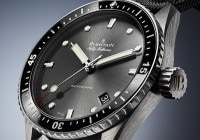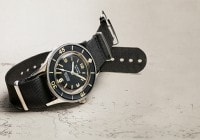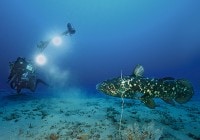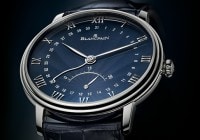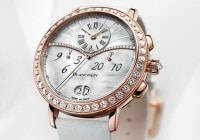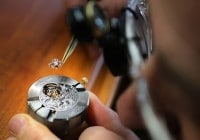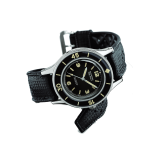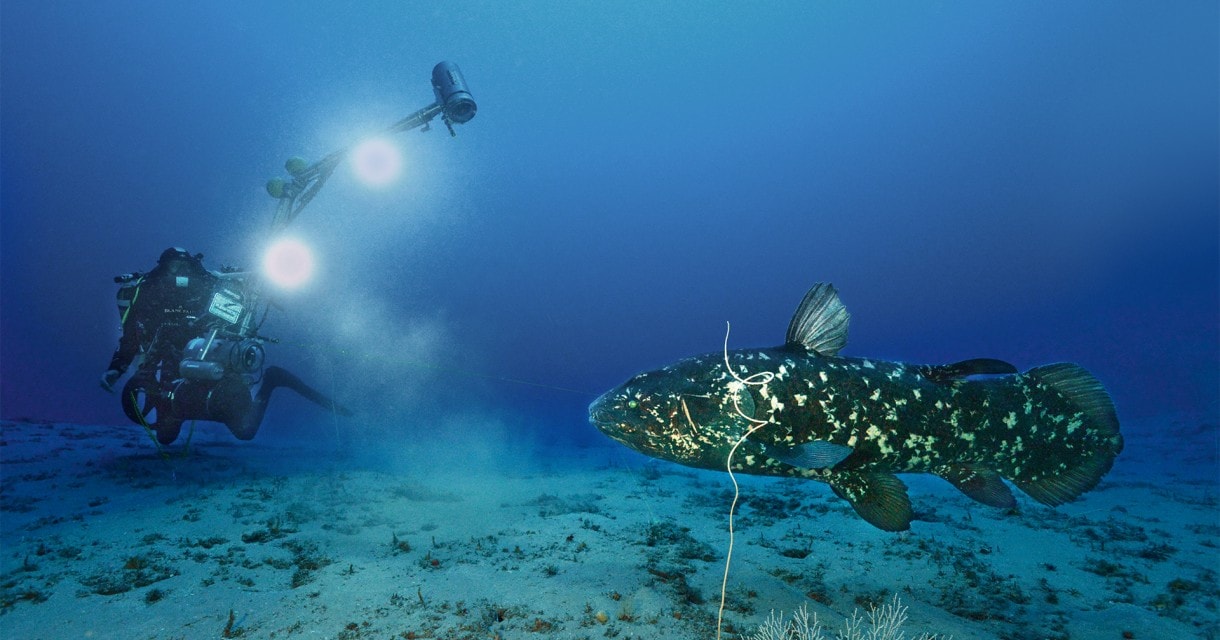
Search in Issues
Chapters
List of parts
Chapter 3
The History and the Legend of the FIFTY FATHOMS
Legends have been written about Blancpain’s iconic Fifty Fathoms; its creator, former CEO Jean-Jacques Fiechter, tells its history.
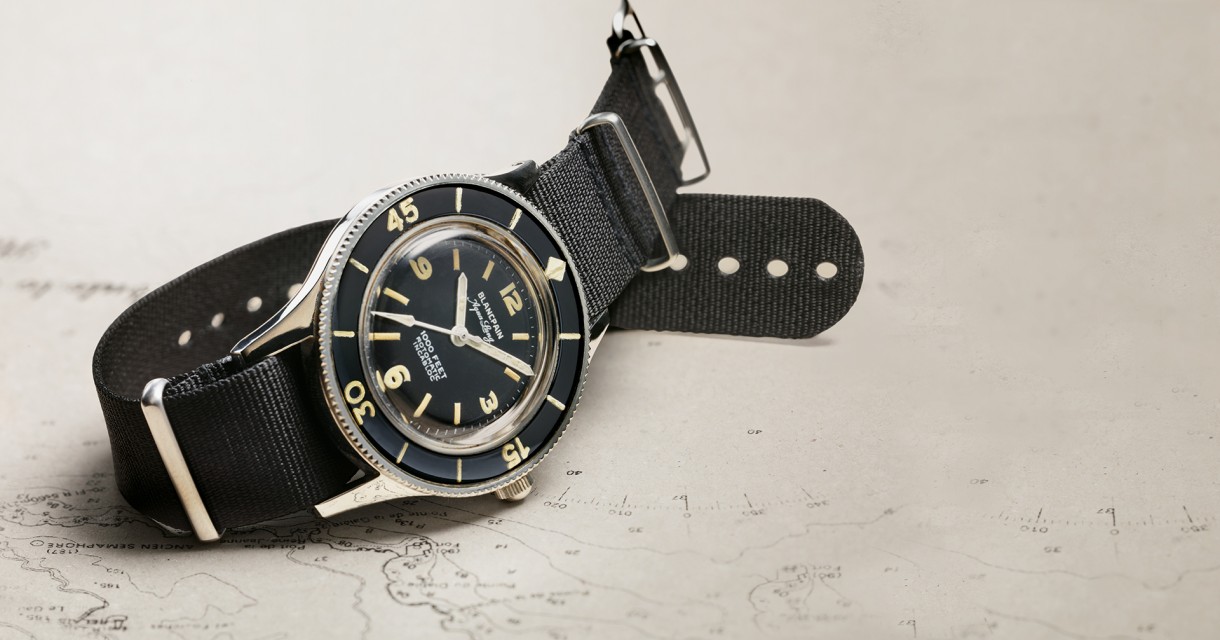
Now in its 60th year, Blancpain’s Fifty Fathoms watch has become a legend. A legend that is steeped in history. The history is a complicated one in that there are two lineages: that of Jean-Jacques Fiechter, Blancpain’s CEO for three decades from 1950-1980, who was himself a passionate diver, and Captain Robert “Bob” Maloubier and Lieutenant Claude Riff aud, both of the French combat diving corps, who needed a watch for their military diving missions. These two poles come together to give birth to the legend. Blancpain was not part of the equation when Maloubier and Riff aud began their quest for a watch in the aftermath of World War II. Both officers saw a timepiece as one of the essentials for their divers and together they developed a list of requirements, specifications, if you will, for the diving watch that they needed. Tests on watches that they found on the market in Paris were disastrous; the watches were petite in size, difficult to read under water and, most catastrophically, leaked. Badly. Separately, Fiechter was devoting himself to his avocation of diving. His passion for the sport kindled an inventive spirit. With his own personal experiences as a diver guiding him, Fiechter began addressing the challenges of timekeeping in the diving milieu. First on his list was obvious: water resistance (and keep in mind the failings of the first watches Maloubier and Riff aud tested). This led him to develop a double sealed crown. As the crown was not one of the screw-down variety, his idea was to protect the watch from water intrusion if the crown were accidentally pulled out while under water. In that event, the inner second seal would protect the watch. Fiechter patented this invention. A second element was a rotating bezel to use for timing of the dive. When he dove, his idea was to rotate the bezel to place its zero index opposite the minute hand at the commencement; thereafter he could directly read time underwater with the minute hand using time markings on the bezel. Again safety was on his mind. He knew that if the bezel were accidentally rotated, this vital timing function would be lost. So Fiechter developed a locking mechanism, which he also patented, to prevent inadvertent rotation of the bezel. His original locking system required a push on the bezel in order for it to rotate. Not only did this help insure against inadvertent turning, it served to protect
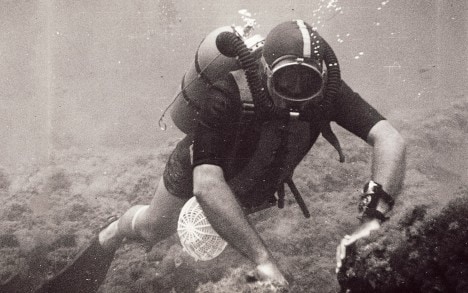
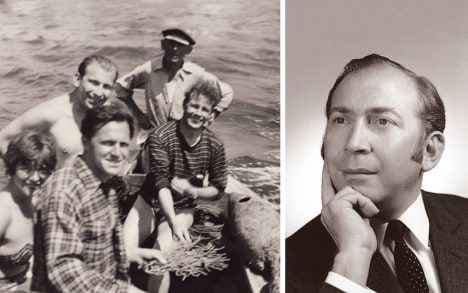
Left: Jean-Jacques Fiechter, Blancpain CEO 1950-1980.
Right: Fiechter on a diving trip in the south of France.
JEAN-JACQUES FIECHTER’S PASSION FOR DIVING led him to develop the key inventions for the Fifty Fathoms.
the bezel from salt and sand interfering with its operation. There was a third patent which he obtained related to the screw-on case back. The problem with previous systems was the “O” ring which seals the back can become twisted and misaligned when the back is screwed in place. Fiechter developed a system to protect against that risk with his design that placed the “O” ring in a channel with an additional metallic ring to maintain its position. Legibility was key, particularly in murky water, leading Fiechter to the idea of endowing a diving watch with large size, a white against black color scheme, and luminous hands and indexes. Automatic winding for the movement was another vital element in his design, done to minimize wear on the crown and its seals, which would occur with manual winding. Finally, because magnets were part of the diving environment as he knew it, Fiechter saw the need to equip a diving timepiece with a soft inner iron case to protect the movement from residual magnetism.
There is the expression “minds think alike” which perfectly describes the conception of diving needs from these two poles working separately; Maloubier and Riffaud in France and Fiechter in Switzerland. Both had formed ideas to define the perfect diving watch. Maloubier and Riffaud had carefully thought through the requirements for the divers and the military mis- sions of the French combat diving corps. Fiechter, from his own diving experience, had done the same. Building a watch embodying his ideas, Fiechter was able to provide a watch for the French to test. The watch passed those tests with flying colors and became a staple of the French combat diving corps and later other navies from around the world.
Fiechter named his creation the “Fifty Fathoms.” On his mind when he did so was Ariel’s song from Shakespeare’s The Tempest. Ariel sings “Full fathom five thy father lies; Of his bones are coral made.” Shakespeare’s reference to “fathoms” in Ariel’s song, resonating well
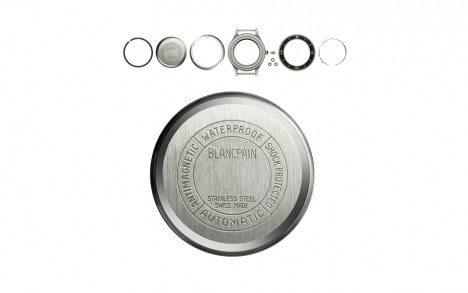
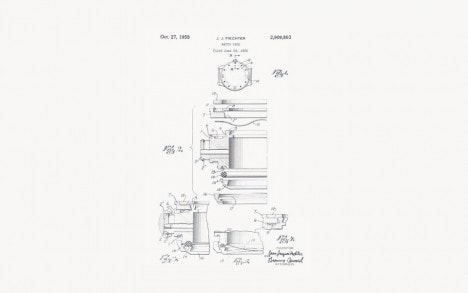
WHY THE NAME “FIFTY FATHOMS”? Look to Shakespeare.
in his head, Fiechter appended the number “fifty” before it; after all “five fathoms” would hardly conjure the image of a deep dive. Indeed, fifty fathoms was thought in these early scuba days as the maximum depth he and other divers might achieve.
For the French military there was a complication, however, with respect to supply. Even though the Fifty Fathoms performed brilliantly and passed all of Maloubier and Riffaud’s tests, buying the watch was not totally straightforward. The French government required that all combat diver supplies, including the diving watches, be purchased from French companies. This led Blancpain to deal with Spirotechnique, a subsidiary of the French conglomerate Air Liquide.
The relationship was natural, as Spirotechnique sold a broad range of diving equipment. One of Spirotechnique’s brands was “Aqualung” and this became the trademark which was used for the Fifty Fathoms watches sold by them.
Blancpain’s connection with Spirotechnique, in turn, led to another highly visible link, that with Jacques-Yves Cousteau. The family of Cousteau’s wife was the owner of Air Liquide, which was the genesis of Cousteau’s collaboration with Spirotechnique to develop better diving tank systems. Of course these, too, were sold under the name “Aqualung”. Cousteau selected the Fifty Fathoms watches for his diving team, whose filmed historic dives in the feature movie “Silent World” were honored with both a Hollywood Oscar and a Cannes Palme d’Or.
There is some debate among aficionados about the attributes of the very first generation of Fifty Fathoms watches. Fiechter provides a comprehensive list of the defining elements: a triangle “zero” marker on the rotating bezel (later models replaced the triangle with a lozenge); the words “Rotomatic” and “Incabloc” on the dial (later models dropped that legend); also on the dial Arabic numerals 12, 3, 6, and 9; a crown rounded in shape (this was done to minimize the risk of the crown catching on nets so as to pull it out; later models had more squared off edges on the crown).
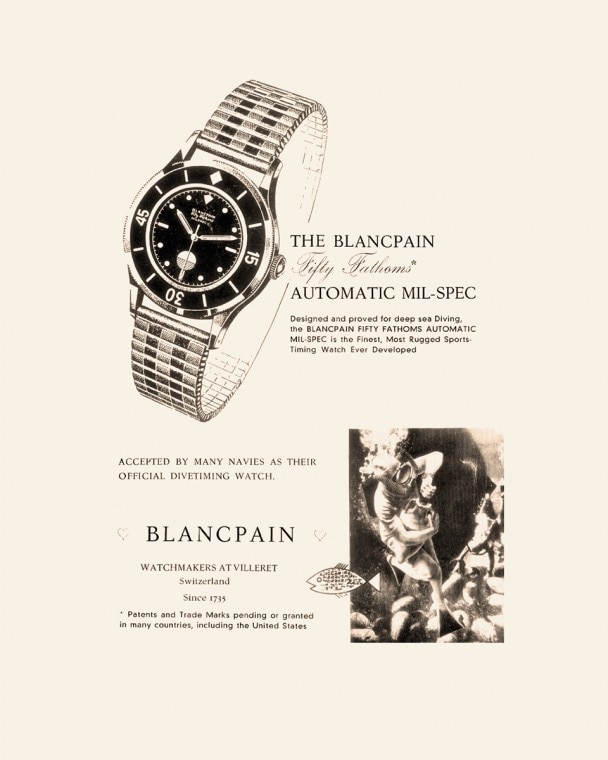
Dedicated collectors have well observed that during Fiechter’s three decades at the helm of Blancpain, many different declinations of the Fifty Fathoms followed after the seminal model. Although it is impossible to describe all the different models that appeared over the thirty-year evolution of this icon under Fiechter’s stewardship, certain highlights or milestones stand out.
Logically, the first highlight takes the form of the first new function added to the watch. This was the inclusion of a moisture indicator on the dial. This feature came at the request of both the French and American navies. If somehow moisture were to find its way into the watch, a disk located at the six o’clock position on the dial would change color from blue to red, signaling the problem.
Another milestone, astonishingly, upon its debut, caused confusion among the hard core divers who adopted the Fifty Fathoms as their go-to watch. Fiechter added a date window. Of course he knew that, strictly speaking, a date indication was not really connected to the serious business of diving, but he thought it a convenient feature nonetheless and, after some hesitancy, incorporated a date window into many models
of the Fifty Fathoms. This provoked a letter from a diver who wrote: “I love my diving watch. But there is a little window with a number, but it jumps from time to time” Of course that is a perfect description of a perfectly normal change of the date indication occurring every 24 hours. Controversy over the inclusion of a date function, today, seems comical where, in a modern world of dive watch “chic”, many complications not strictly tied to diving are eagerly snapped up by collectors who rightly see complications adding to the overall allure of their timepieces. Thus, in its current Fifty Fathoms Collection, Blancpain offers not only date indications, but chronographs, complete calendar moon phases, and tourbillons.
Previously misunderstood was the famous “No Radiations” version of the Fifty. which was offered in the 1950’s. According to the legend, the yellow circle with the atomic symbol, slashed circle and notation “No Radiations” was a feature of the civilian models of the Fifty Fathoms to differentiate them from military versions which used radioactive materials such as radium on hands and indexes so as to glow in the dark. Fiechter’s history diverges from this tale. Yes, the “No Radiations” markings were used on the watch as Blancpain employed tritium, which is essentially non-radioactive, on hands and indexes for illumination in the dark.
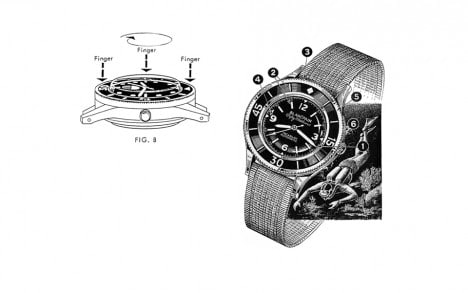
Instructions for using the original locking bezel.
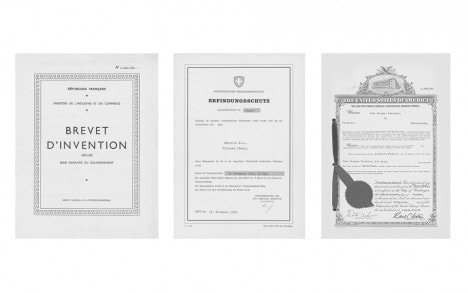
OVER THE MANY DECADES of its history, multiple variations in design appeared, all faithful to its diving mission.
However, Blancpain used tritium on all its Fifty Fathoms watches of the time, military included. Radium was never used. The markings did not signify a difference in materials, merely the absence of something that might otherwise cause concern.
Another variation that Blancpain produced during the Fiechter era was the no lug cushion case design. The request came from the German military and, over the years, many variations of this basic style were offered in the Fifty Fathoms line, particularly during the 1970’s. The German military models bore upon the dial a circle with “3H” written on the inside. One particularly noteworthy variant was one that dispensed with the rotating exterior bezel, which was replaced by a rotating ring on the dial.
No history of the Fifty Fathoms would be complete without a chapter devoted to Allen V. Tornek. Tornek was a diamond dealer on 40th street in New York. He and Fiechter connected through Fiechter’s brother, René, who lived in America. Although Fiechter’s aunt, Betty, had begun selling Blancpain movements in the U.S. prior to the Second World War (customs duties made it economically difficult to sell completed watches), Blancpain’s U.S. presence blossomed as the relationship between Fiechter and Tornek grew closer. It was Tornek who saw the opportunity to supply the American Navy with Fifty Fathoms watches. The Navy specifications were demanding. Not a single U.S. watch manufacturer found a way to comply (It is easy to forget that after the war, there was a viable, vibrant, and successful U.S. watch industry). Blancpain could not supply directly as it was not a U.S. company, one of the requirements. But Tornek could. In order to qualify, he had to create a small testing laboratory in the U.S. so that the watches could be tested and certified on U.S. soil. Tornek and Blancpain successfully landed the contract and the famous “Milspec 1” Fifty Fathoms was born as the U.S. Navy’s dive watch. In addition to the “Milspec 1” marking on the dial, this edition of the Fifty Fathoms featured a mat finish case. The first order from the Navy was, however, considering all the difficulties in complying with the bid requirements, both bizarre and disappointing. The quantity ordered: 611! No explanation for how the government arrived at that very precise number.
There was a “Milspec 2” version which was released later. This ultra rare edition was built to be a-magnetic. This means that the amount of magnetic material in the watch was reduced to the bare minimum so that the watch would not set off magnetically released triggers. Think bombs and torpedoes.

A vintage “No Radiations” model.
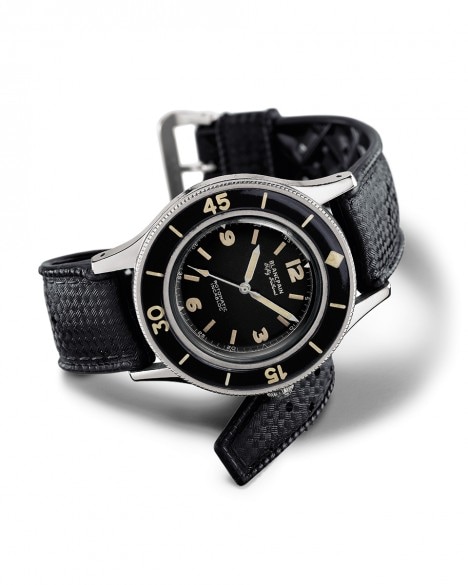

AS THE BLANCPAIN BATON passed from Fiechter to Marc A. Hayek, the evolution of the Fifty Fathoms has been re-energized.
The case was fashioned out of a special formulation of steel that was a-magnetic rather than the customary stainless steel. The steel components of the movement were made of Beryllium, softer than steel, but for the anticipated military purposes where longevity and resistance to scratches was not a factor, not an obstacle. The Milspec 2’s stealth mission was further enhanced by a blasted mat finish on the case to minimize the risk of reflec- tions. These Milspec 2 editions are marked simply “Milspec” on the dial. This highly specialized, and some would say ultimate Milspec watch, dubbed the TR-900 by Tornek, was produced in very small numbers with 780 delivered to the U.S. Navy in 1964 and approximately 300 more in 1966.
Jean-Jacques Fiechter withdrew as CEO of Blancpain in 1980, which brought to a temporary close the evo- lution of the Fifty Fathoms. Not until nearly 20 years later, in 1999, did another model appear, the Fifty Fathoms from the Trilogy Collection, launched during the Jean-Claude Biver era.
The true rebirth came under the stewardship of Marc A. Hayek. In 2003 came the launch of the Anniversary Fifty Fathoms, three limited series of 50 watches each, which have now become highly sought after collector
pieces. The Anniversary was but an overture, however, for the full re-establishment of a true Fifty Fathoms Collection, which debuted in 2007. Now firmly cemented as one of the key pillars of modern Blancpain, the Fifty Fathoms Collection has been enriched with new models every single year since the 2007 rebirth.

Jean-jacques Fiechter in 2013.
Other issues
Don't miss the latest issue
Sign Up for New Releases

